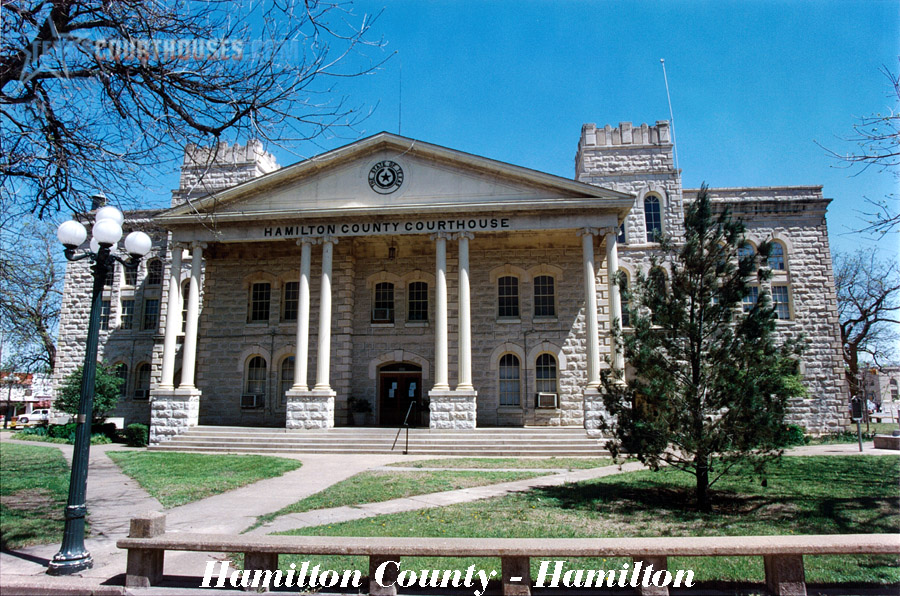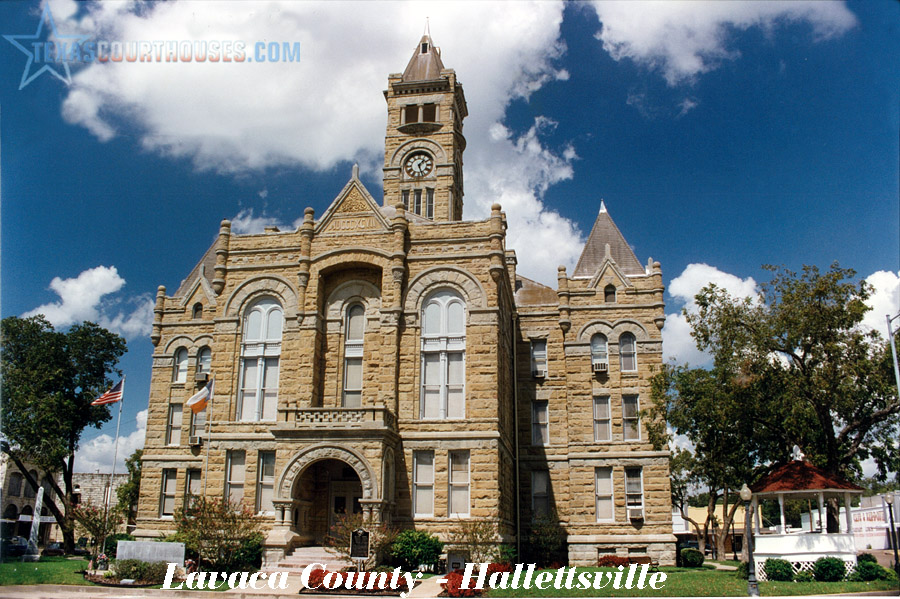1st Courthouse
Building Completion Date:
County Seat: Hamilton
Present Status: Gone. Burned 1863
Building Materials/Description: Vernacular, frame
2nd Courthouse
Building Completion Date: 1871
County Seat: Hamilton
Present Status: Gone. Burned 1877
Building Materials/Description: Stone, 2 story, rented
3rd Courthouse
Building Completion Date: 1878
County Seat: Hamilton
Present Status: Gone. Burned 1886
Architectural Firm: Martin, Byrne & Johnson
General Contractor: Mason, Martin, Johnson & Byrnes
Building Materials/Description: Limestone, possibly quarried at site of present city dump, 2-story, $29,700
4th Courthouse
Building Completion Date: 1886
County Seat: Hamilton
Present Status: Existing. Part of 1931 courthouse
Architect: William Martin
Architectural Firm: Mason, Martin, Byrne, & Johnston
Architectural Style: Second Empire
General Contractor: Tom Lovell (Denton)
Building Materials/Description: The building was originally constructed of native limestone in the Second Empire style and surmounted by a tall clock tower. In 1931, it was remodeled into a Classical Revival structure. $30,700
5th Courthouse
Building Completion Date: 1931
County Seat: Hamilton
Present Status: Existing. Active.
Architect: E.M. Miles
Architectural Style: Classical Revival
General Contractor: J. C. Ray & Son
Building Materials/Description: Stone, $55,754. Central tower with mansard roofs removed, new design features building additions of crenellated projecting towers flanking a broad pedimented portico with paired Ionic columns added by E.M. Miles.
National Register Narrative The original design of the Hamilton County Courthouse was similar to that of many other courthouses built in the state during the 1880s. The ground floor plan was divided into office quadrants by north-south and east-west corridors extending through the building. On the second floor was a spacious courtroom.
Originally, the building was in the Second Empire style. Pavilions at each corner were crowned by Mansardic roofs with dormers. Yet another Mansardic roof surmounted the center section. Crowning the composition was a centrally positioned tower with wooden framework covered by sheetmetal skin into which Classical details had been pressed.
As was characteristic of Victorian courthouses, a variety of stone-work was employed to enhance the edifice in Hamilton. Walls were quarry-faced ashlar limestone. Window openings on the ground level were spanned with Roman arches with cut-stone voussoirs; those on the second level were spanned with stilted arches.
In 1931-1932 the building was enlarged. Following plans prepared by E. M. Miles, contractor J. C. Ray and Sons changed the character of the building. Wings were added to the north and south and porticoes with triangular pediments were added to the east and west. Square towers rising above the roof lines provided a transition between the new and the old.
Additional harmony between the new and the old was developed through the exterior details. The stonework on the additions was similar to the nineteenth century work. Ashlar patterns of quarry-faced stones, along with cut-stone quoins, all provided unity. Then the Roman-arched openings with cut-stone voussoirs created an additional relationship with the older sections of the building.
The Hamilton County Courthouse possesses both architectural and historical significance. Architecturally, the original nineteenth-century building incorporated handsome details and sound construction. In the twentieth century, rather than erecting a new building as was done in many counties, Hamilton County Commissioners decided to authorize additions which were fashionable for their times, yet were quite compatible with older section–a unique composition of forms resulted. Historically, by expanding in this manner, the original courthouse was able to serve as a center of county activities for over three quarters of a century.
The nineteenth-century section of the building incorporated details that were typical of Second-Empire styled edifices. Both Roman and segmental arches of cut stone with pronounced keystones spanned the openings. The walls were further enhanced by fine stonework, including cut stone quoins and ashlar patterns.
Significantly, in developing harmonizing designs for the addition, the architects repeated the use of Roman arches to span the openings. At the base of each tower is a tympanum that incorporated low relief figures relating to the history of the county–a trend in symbolism that appeared in other Texas courthouses built at the same time. Impressions of cowboys, Indians and livestock are among those displayed under the arches. The ashlar patterns of stonework of the original also were repeated in the additions. Then, the location of the top cut-stone stringcourse of the original four pavilions became the level of the coping in the new addition, thus creating a continuous line tying the new to the old. Below this was placed an entablature of cut stone. To further unity the entire composition on the north and south and to provide the monumental character that was so much admired in the early decades of the twentieth century, porticoes with paired columns of colossal order placed upon pedestals were incorporated into the design. Capitals were in the Ionic order, and the entablature and pediment were simply detailed. In the pediment was placed the seal of the State of Texas. Of course the removal of the Mansard roofs from the original section was necessary to allow the development of unity between the new and the old.
Hamilton County was created from parts of the surrounding counties in 1858, four years after the first permanent settlement was initiated by Robert Carter. Located in west-central Texas, it developed an economy primarily based upon agriculture. Before the Civil War the county population was less than 500 and as late as 1870 it was still under 1,000. As was characteristic of newly settled areas, the population mushroomed after the arrival of the railroads and by the turn of the century was over 13,000.
Typical of fledgling counties, the Hamilton County government was housed in make-shift quarters during the first years. In 1869 Jones Store was used for a $2 fee. Two years later it was recorded that the school house was used for district court. During the early 1870s a “rock house” was rented; however, this building burned in 1877.
Shortly thereafter, the plans and proposal of contractors Martin, Moody and Johnston were accepted for a new $12,000 temple of justice built in the center of the public square. It was completed in less than a year. However, in 1886 misfortune struck again and this courthouse also burned. Fortunately a fireproof record vault with double walls of bricks and a brick barrel vault overhead protected some of the records.
After an election determined that the seat of justice should remain in Hamilton–rather than “J. D. Hunt’s location or Pigtown”–plans submitted by contractors Martin, Byrnes and Johnston were accepted. Bids were solicited through advertisement in the Dallas bloming News and the contract to build the new $60,000 temple was awarded to Lovell, Hood and McLeod of Brownwood, Texas. Final payment on the building was made in February, 1887. It had been built in nine months.
The interior incorporated fireproof construction. The second floor was supported on corrugated iron arches over which was placed concrete.
Through additions and remodelings the courthouse has been expanded and updated. Today it continues to serve the needs of county government. Throughout its history the courthouse, with the surrounding commercial buildings, has been a center of many types of functions, including social, legal, justice and commercial activities. Local residents affectionately associate the monumental building with the history of the development of the county.


